アモルファス物質
Dan Wei, Yun-Jiang Wang, Shigenobu Ogata,“Statistical structural mechanism for shear localization in amorphous materials”, Acta Materialia, 298 (2025) 121385.
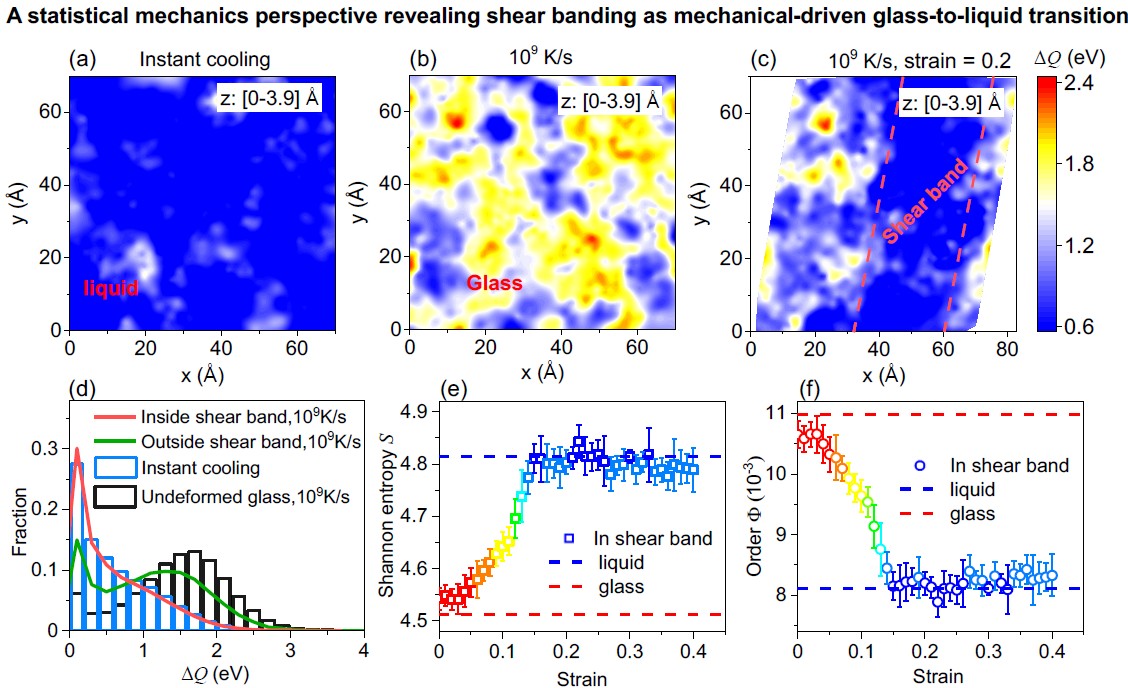
Shear localization is a prevalent phenomenon in amorphous materials undergoing plastic deformation, yet its underlying structural mechanism at the atomic scale remains elusive. Here we introduce a quantitative approach to correlate structural order and disorder with the degree of shear localization in amorphous materials. This approach relies on two fundamental physical parameters: the statistical structural order, derived from Shannon entropy of local Voronoi structures, and the localization susceptibility, characterized by spatial correlations in atomicscale von Mises strain. Extensive atomistic simulations validate our approach and reveal a universal relationship between structural order and shear localization across a wide range of amorphous solids, each with distinct chemical compositions and thermal histories. We interpret the correlation between structural order and shear localization within a framework of shear banding as a mechanically-driven glass transition, governed by a structural collapse analogous to thermodynamic glass transitions on the potential energy landscape.
ページトップChih-Jen Yeh, Chang-Wei Huang, Yu-Chieh Lo, Shigenobu Ogata, Ding Yuan Li, Hsuan-Teh Hu, Jason Shian-Ching Jang,“Effect of nanoglass grain size investigated by a mesoscale variable characteristic strain model”, International Journal of Mechanical Sciences, 266 (2024) 108981-1-15.
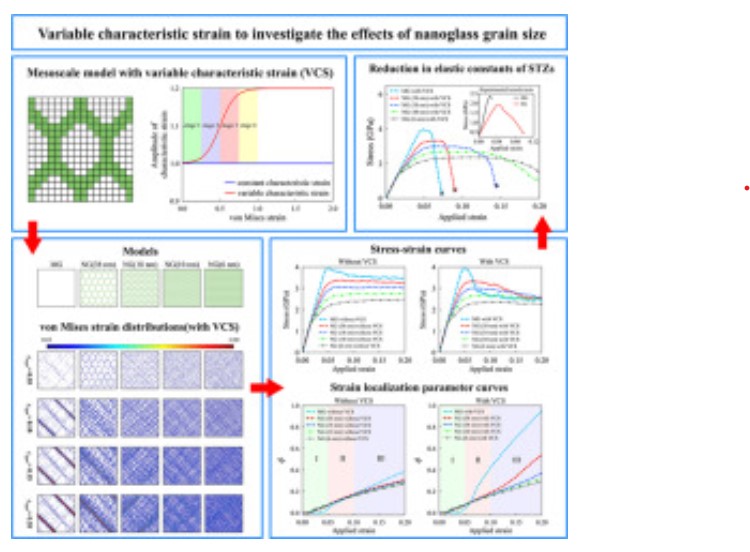
Severe shear localization in metallic glasses (MGs) significantly limits their mechanical performance. Nanoglass (NG), composed of heterogeneous glassy domains created by introducing interfaces into MGs at the nanoscale, could be a promising strategy against severe shear localization, as demonstrated by numerous atomistic simulations. This study introduces a novel mesoscale kinetic Monte Carlo (kMC) model with a variable characteristic strain (VCS) to investigate the grain size effect in NGs. This model captures the complex evolution of shear bands during deformation, revealing a surprising transition from inhomogeneous to homogeneous deformation as the NG grain size decreases to approximately 10 nm. This transition is attributed to the impediment of shear band formation by the small grain size, facilitated by softer interfaces guiding early shear transformation zone (STZ) activities across the entire sample. Furthermore, a progressive reduction of elastic constants simulates the failure response observed in experiments. Our model predicts a critical grain size for the transition in agreement with molecular dynamics simulations and experiments, highlighting its potential for designing NGs with enhanced shear resistance. This mesoscale model enables the investigation of NG deformation with microstructural features on an experimentally-relevant spatial-temporal scale. This paves the way for tailoring NG microstructures to achieve enhanced mechanical performance, and opens new avenues for exploring the influence of interfaces in controlling shear localization.
ページトップAkio Ishii, “Spatial and temporal heterogeneity of Kohlrausch–Williams–Watts stress relaxations in metallic glasses”, Computational Materials Science, 198 (2021) 110673-1-5.
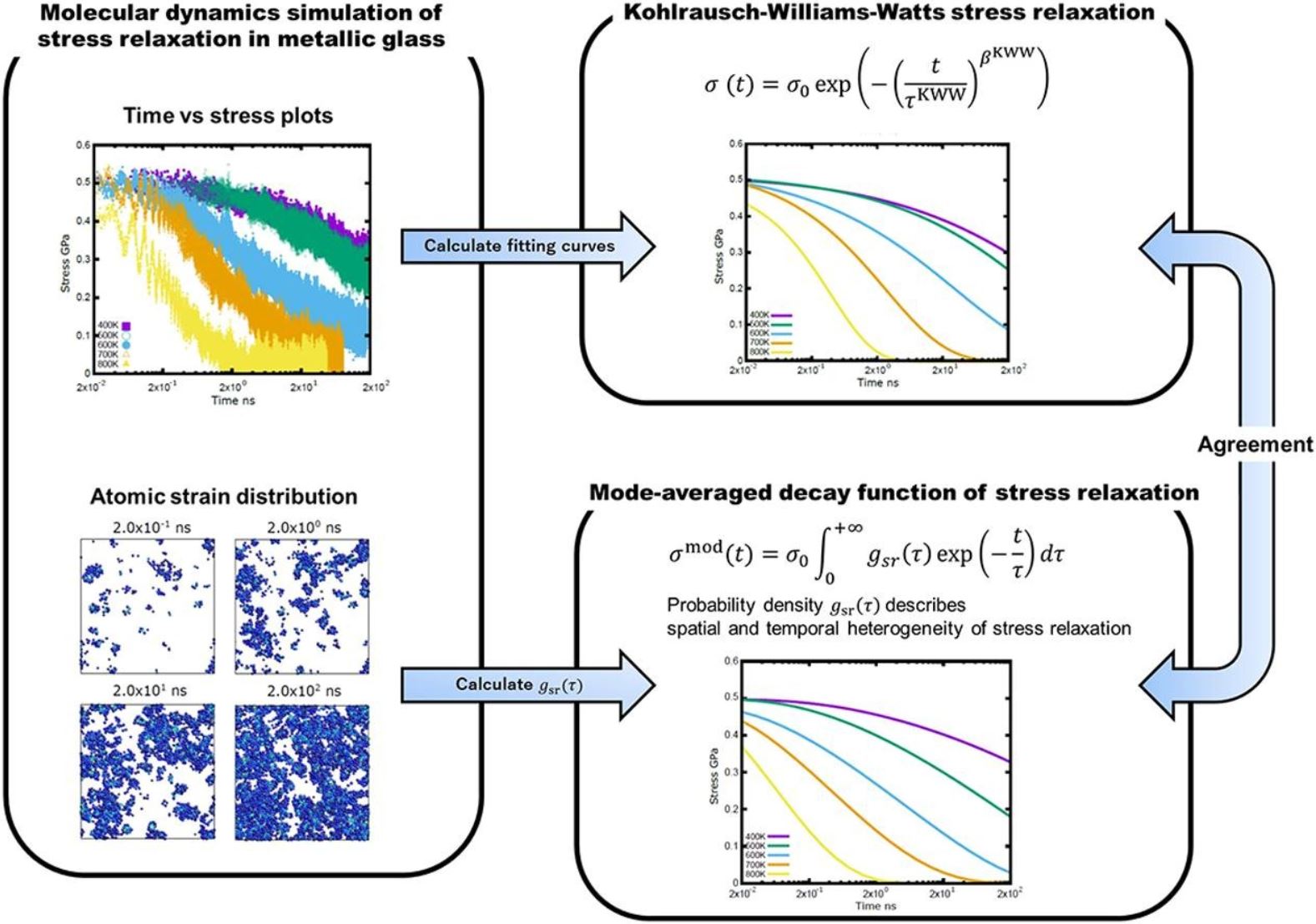
We perform a molecular dynamics (MD) stress relaxation simulation for Zr50Cu40Al10 metallic glass to confirm that the time dependency of stress relaxation conforms with the Kohlrausch–Williams–Watts (KWW) equation, and to derive the temperature dependency of the Kohlrausch exponent βKWW. We also calculate local plastic deformation based on atomic strain, then discuss the morphology of relaxation and calculate the probability density of stress relaxation with respect to the characteristic time of relaxation from the number of deformed atoms. Afterward, we derive the time dependency of stress relaxation as a mode-averaged decay function, which expresses spatial and temporal heterogeneity. Both the results of simulation and calculation reproduce the KWW relaxation form and are in good agreement, confirming the spatially and temporally heterogeneous nature of KWW relaxation. The heterogeneity of the stress relaxation of metallic glass is determined by local stress changes caused by microscopic local plastic deformation.
ページトップTomoaki Niiyama, Masato Wakeda, Tomotsugu Shimokawa, Shigenobu Ogata, “Structural relaxation affecting shear-transformation avalanches in metallic glasses”, Physical Review E, 100 (2019) 043002-1-10.
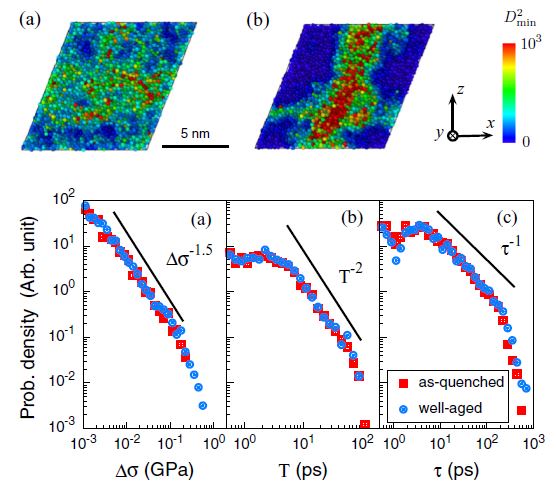
Structural relaxation by thermal treatments can dramatically alter the mechanical properties of metallic amorphous solids (metallic glasses), especially brittleness related to shear band nucleation. Using molecular dynamics simulations of shear deformation in two thermally processed metallic glass models, we investigate the morphology of the shear transformation avalanches, which is characterized by the power-law statistics. The two typical cases that are based on a less-relaxed (as-quenched) glass and a well-relaxed (well-aged) glass are investigated. During deformation, a shear-band like heterogeneous pattern is observed in the well-relaxed glass model, whereas the less-relaxed model exhibits homogeneous deformation patterns. By evaluating the spatial correlation functions of the non-affine least square displacements of atoms during each elemental avalanche event, we reveal that the shapes of avalanche regions in well-relaxed glasses tend to be anisotropic whereas those in less-relaxed glasses are isotropic. Further, we demonstrate that a temporal clustering of the direction of avalanche propagations and a considerable correlation between the anisotropy and size of an avalanche emerge in the well-relaxed glass model.
ページトップGuo-Jie Jason Gao, Yun-Jiang,Wang, and Shigenobu Ogata, "Incorporating a soft ordered phase into an amorphous configuration enhances its uniform plastic deformation under shear", AIP Advances, 9 (2019) 15329.
Amorphous materials of homogeneous structures usually suffer from nonuniform deformation under shear, which can develop into shear localization and eventually destructive shear band. One approach to tackle this issue is to introduce an inhomogeneous structure containing more than one phase, which can reduce the local nonuniform shear deformation and hinder its percolation throughout the system. Using thermostated molecular dynamics (MD) simulations, we compare the deformation behavior between a homogeneous amorphous mixture of bidisperse disc particles, interacting via an n-6 Lennard-Jones potential of tunable softness, with an inhomogeneous one containing an evenly-distributed ordered phase. We change the population ratio of large to small particles to create a homogeneous or an inhomogeneous mixture, where the softness of a chosen phase can be manually adjusted by specifying n of the interparticle potential. Results of applying extensive quasistatic shear on the prepared mixtures reveal that the inhomogeneous amorphous mixture containing a soft ordered phase overall deforms more uniformly than the homogeneous one, which indicates that both the structure inhomogeneity and the inter-phase softness variance play important roles in enhancing the uniformity of the plastic deformation under shear.
ページトップXie Xie, Yu-Chieh Lo, Yang Tong, Junwei Qiao, Gongyao Wang, Shigenobu Ogata, Hairong Qi, Karin A. Dahmen, Yanfei Gao, and Peter K. Liawa, "Origin of serrated flow in bulk metallic glasses" , Journal of the Mechanics and Physics of Solids, 124 (2019) 634-642.
Bulk metallic glasses (BMGs) possess amorphous structure and show unique mechanical properties, such as extremely high strength and excellent damage tolerance, entitling them as potential structural materials. So far a great amount of work has been conducted to study BMGs’ macroscopic mechanical properties and examine corresponding microscopic deformation defects. However, the connection between macroscopic inhomogeneous deformation at room temperature and microscopic deformation carriers is still poorly understood, due to the lack of an appropriate experimental technique to directly probe the inhomogeneous deformation process on the proper spatial and temporal scales. Here we present the deformation details via in situ thermal imaging about the evolution of heat bands associated with successive serration behavior. For the first time, our experimental work clarifies the coupling of serrated flows with shear band activities, especially the often omitted fine serrations induced by shear band nucleation or the early stage of propagation. Meanwhile, serration behavior of BMGs is simulated through the kinetic Monte Carlo (kMC) method by integrating local heating (thermal softening and β-relaxation) effects, which exhibits good agreement with experimental results. These findings will advance our fundamental understanding of the shear band operation down to microscopic level, which may shed light on the control of shear banding for the application of BMGs.
ページトップYun-Jiang Wang, Jun-Ping Du, Shuhei Shinzato, Lan-Hong Dai and Shigenobu Ogata, "A free energy landscape perspective on the nature of collective diffusion in amorphous solids", Acta Materialia, 157 (2018) 165-173.
The nature of collective diffusion in amorphous solids is in strong contrast with diffusion in crystals. However, the atomic-scale mechanism and kinetics of such collective diffusion remains elusive. Here the free energy landscape of collective diffusion triggered by single atom hopping in a prototypical Cu50Zr50 metallic glass is explored with well-tempered metadynamics which significantly expands the observation timescale of diffusion at atomic-scale. We clarify an experimentally suggested collective atomic diffusion mechanism in the deep glassy state. The collective nature is strongly temperature-dependent. It evolves from string-like motion with only several atoms to be large size collective diffusion at high temperature, which can promote the atomic transport upon glass transition temperature. We also clarify the apparent diffusivity is dominated by the highest free energy barrier of atomic diffusion among widely distributed free energy barriers due to the dynamic heterogeneity of metallic glass, which suggests the sequential nature of diffusion is a proper assumption to the metallic glasses with dynamic heterogeneity. The temperature and pressure dependence of diffusion free energy landscape are further quantified with activation entropy, (19.6 ± 2.5)kB, and activation volume, (7.9 ± 3.4) Å3, which agree quantitatively with experiments. Laboratory timescale simulations of atomic diffusion brings physical insights into the unique atomic motion mechanism in non-crystalline materials.
ページトップJunji Saida, Rui Yamada, Masato Wakeda, and Shigenobu Ogata, "Thermal rejuvenation in metallic glasses", Science and Technology of Advanced Materials, 18-1 (2017) 152-162.
Structural rejuvenation in metallic glasses by a thermal process (i.e. through recovery annealing) was investigated experimentally and theoretically for various alloy compositions. An increase in the potential energy, a decrease in the density, and a change in the local structure as well as mechanical softening were observed after thermal rejuvenation. Two parameters, one related to the annealing temperature, T a/T g, and the other related to the cooling rate during the recovery annealing process, V c/V i, were proposed to evaluate the rejuvenation phenomena. A rejuvenation map was constructed using these two parameters. Since the thermal history of metallic glasses is reset above 1.2T g, accompanied by a change in the local structure, it is essential that the condition of T a/T g ≥ 1.2 is satisfied during annealing. The glassy structure transforms into a more disordered state with the decomposition of icosahedral short-range order within this temperature range. Therefore, a new glassy structure (rejuvenation) depending on the subsequent quenching rate is generated. Partial rejuvenation also occurs in a Zr55Al10Ni5Cu30 bulk metallic glass when annealing is performed at a low temperature (T a/T g ~ 1.07) followed by rapid cooling. This behavior probably originates from disordering in the weakly bonded (loosely packed) region. This study provides a novel approach to improving the mechanical properties of metallic glasses by controlling their glassy structure.
ページトップYuji Sato, Chiaki Nakai, Masato Wakeda, and Shigenobu Ogata, “Predictive modeling of Time-Temperature-Transformation diagram of metallic glasses based on atomistically-informed classical nucleation theory”, Scientific Reports, 7 (2017) 7194-1-9.

Theoretical prediction of glass forming ability (GFA) of metallic alloys is a key process in exploring metallic alloy compositions with excellent GFA and thus with the ability to form a large-sized bulk metallic glass. Molecular dynamics (MD) simulation is a promising tool to achieve a theoretical prediction. However, direct MD prediction continues to be challenging due to the time-scale limitation of MD. With respect to practical bulk metallic glass alloys, the time necessary for quenching at a typical cooling rate is five or more orders of magnitude higher than that at the MD time-scale. To overcome the time-scale issue, this study proposes a combined method of classical nucleation theory and MD simulations. The method actually allows to depict the time-temperature-transformation (TTT) diagram of the bulk metallic glass alloys. The TTT directly provides a prediction of the critical cooling rate and GFA. Although the method assumes conventional classical nucleation theory, all the material parameters appearing in the theory were determined by MD simulations using realistic interatomic potentials. The method is used to compute the TTT diagrams and critical cooling rates of two Cu-Zr alloy compositions (Cu50Zr50 and Cu20Zr80). The results indicate that the proposed method reasonably predicts the critical cooling rate based on the computed TTT.
ページトップJunji Saida, Rui Yamada, Masato Wakeda, and Shigenobu Ogata, "Thermal rejuvenation in metallic glasses", Science and Technology of Advanced Materials, 18-1 (2017) 152-162.
Structural rejuvenation in metallic glasses by a thermal process (i.e. through recovery annealing) was investigated experimentally and theoretically for various alloy compositions. An increase in the potential energy, a decrease in the density, and a change in the local structure as well as mechanical softening were observed after thermal rejuvenation. Two parameters, one related to the annealing temperature, Ta/Tg, and the other related to the cooling rate during the recovery annealing process, Vc/Vi, were proposed to evaluate the rejuvenation phenomena. A rejuvenation map was constructed using these two parameters. Since the thermal history of metallic glasses is reset above 1.2Tg, accompanied by a change in the local structure, it is essential that the condition of Ta/Tg ≥ 1.2 is satisfied during annealing. The glassy structure transforms into a more disordered state with the decomposition of icosahedral short-range order within this temperature range. Therefore, a new glassy structure (rejuvenation) depending on the subsequent quenching rate is generated. Partial rejuvenation also occurs in a Zr55Al10Ni5Cu30 bulk metallic glass when annealing is performed at a low temperature (Ta/Tg ~ 1.07) followed by rapid cooling. This behavior probably originates from disordering in the weakly bonded (loosely packed) region. This study provides a novel approach to improving the mechanical properties of metallic glasses by controlling their glassy structure.
ページトップNarumasa Miyazaki, Yu-Chieh Lo, Masato Wakeda, and Shigenobu Ogata, “Properties of high-density, well-orderd, and high-energy metallic glass phase designed by pressurized quenching”, Applied Physics Letters, 109 (2016) 091906.
We applied gigapascal-level compressive hydrostatic pressure to the melt-quenching process of metallic glass to obtain a unique high-pressure glass state with high density that is well-ordered yet has high energy. This state contradicts the common understanding that high-density, well-ordered metallic glass states have low energy. Through molecular dynamics simulations, we found that the high-pressure glass state of the metallic glass Zr50Cu40Al10 has a rich anti-free volume and that its relaxation is dominated by the annihilation of full icosahedra and the rich anti-free volume. The aging rate of the high-pressure metallic glass state (energy reduction rate) is almost the same as that of typical high-energy metallic glass, suggesting that it has a lifetime similar to that of a typical high-energy metallic glass that has been experimentally realized and reported previously [Wakeda et al., Sci. Rep. 5, 10545 (2015)]. Thus, the high-pressure phase can be realized even under the experimental cooling rate, suggesting its suitability for practical applications.
ページトップNarumasa Miyazaki, Masato Wakeda, Yun-Jiang Wang and Shigenobu Ogata, “Prediction of pressure-promoted thermal rejuvenation in metallic glasses”, npj Computational Materials, 2 (2016) 16013.
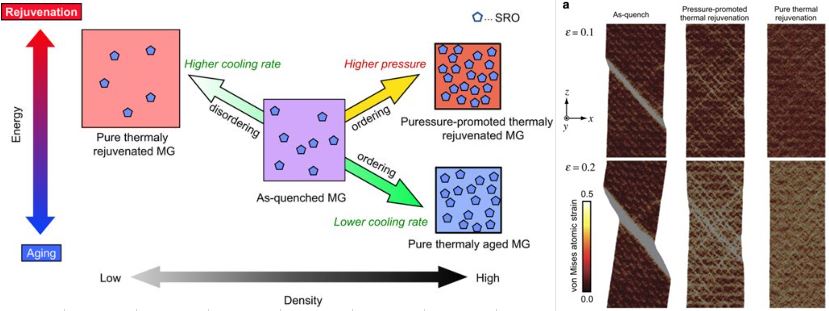
Rejuvenation is the structural excitation of glassy materials, and is a promising approach for improving the macroscopic deformability of metallic glasses. This atomistic study proposes the application of compressive hydrostatic pressure during the glass-forming quenching process and demonstrates highly rejuvenated glass states that have not been attainable without the application of pressure. Surprisingly, the pressure-promoted rejuvenation process increases the characteristic short- and medium-range order, even though it leads to a higher-energy glassy state. This ‘local order’–‘energy’ relation is completely opposite to conventional thinking regarding the relation, suggesting the presence of a well-ordered high-pressure glass/high-energy glass phase. We also demonstrate that the rejuvenated glass made by the pressure-promoted rejuvenation exhibits greater plastic performance than as-quenched glass, and greater strength and stiffness than glass made without the application of pressure. It is thus possible to tune the mechanical properties of glass using the pressure-promoted rejuvenation technique.
ページトップMasakazu Tane, Hajime Kimizuka, and Tetsu Ichitsubo, “Two distinct crystallization processes in supercooled liquid”, Journal of Chemical Physics, 144 (2016) 194505-1-10.
Using molecular dynamics simulations we show that two distinct crystallization processes, depending on the temperature at which crystallization occurs, appear in a supercooled liquid. As a model for glass-forming materials, an Al2O3 model system, in which both the glass transition and crystallization from the supercooled liquid can be well reproduced, is employed. Simulations in the framework of an isothermal-isobaric ensemble indicate that the calculated time-temperature-transformation curve for the crystallization to gamma(defect spinel)-Al2O3 exhibited a typical nose shape, as experimentally observed in various glass materials. During annealing above the nose temperature, the structure of the supercooled liquid does not change before the crystallization, because of the high atomic mobility (material transport). Thus, the crystallization is governed by the abrupt crystal nucleation, which results in the formation of a stable crystal structure. In contrast, during annealing below the nose temperature, the structure of the supercooled liquid gradually changes before the crystallization, and the formed crystal structure is less stable than that formed above the nose temperature, because of the restricted material transport.
ページトップMasato Wakeda, Junji Saida, Ju Li, Shigenobu Ogata, “Controlled Rejuvenation of Amorphous Metals with Thermal Processing”, Scientific Reports, 5 (2015) 10545-1-8.
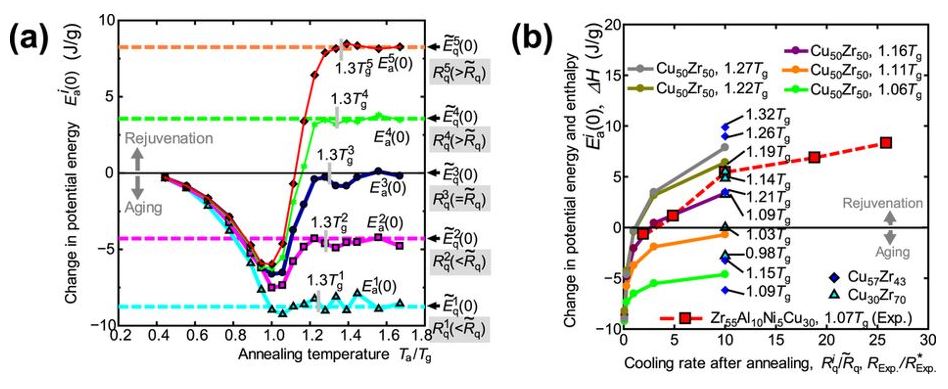
Rejuvenation is the configurational excitation of amorphous materials and is one of the more promising approaches for improving the deformability of amorphous metals that usually exhibit macroscopic brittle fracture modes. Here, we propose a method to control the level of rejuvenation through systematic thermal processing and clarify the crucial feasibility conditions by means of molecular dynamics simulations of annealing and quenching. We also experimentally demonstrate rejuvenation level control in Zr55Al10Ni5Cu30 bulk metallic glass. Our local heat-treatment recipe (rising temperature above 1.1Tg, followed by a temperature quench rate exceeding the previous) opens avenue to modifying the glass properties after it has been cast and processed into near component shape, where a higher local cooling rate may be afforded by for example transient laser heating, adding spatial control and great flexibility to the processing.
ページトップMasato Wakeda, Yoji Shibutani, Shigenobu Ogata, “Atomistic Study on Medium-Range Order Structures in Amorphous Metals”, Journal of the Society of Materials Science, Japan, 64-3 (2015) 156-162 [in Japanese].
Amorphous metals have excellent properties, such as large elastic elongation, high fracture toughness and high corrosion resistance. These properties may arise from their disordered atomic structures, which are totally different from the crystalline structures with long-range periodic order. However, detailed structure of amorphous metals is still a controversial issue, because the experimental diffraction methods have a difficulty to reveal detailed structural features of amorphous metals. Using molecular dynamics methods with binary Lennard-Jones Cu-Zr interatomic potentials, we in this study investigated topological feature of amorphous metals focusing on a medium-range order (MRO). We conducted melt-quenching simulations and constructed amorphous alloy models with three different Cu concentrations. MRO clustering of icosahedra structures which consist of interpenetrating icosahedra links were found in a constructed amorphous structure. In the amorphous model, there are many small and a few large MRO clusters, and the number of MRO clusters monotonically decreases with increasing its size. During the melt-quenching process, the size of MRO cluster rapidly increases with increasing the number of icosahedra at around the glass transition temperature Tg. It is implied that the rapid increase of the size of MRO cluster is caused by a clustering between MRO clusters as well as a growth of each MRO cluster. An amorphous model with more icosahedral clusters tends to have larger, denser and more MRO clusters, and a maximum size of the icosahedral MRO cluster is ~4nm. Based on both the radius of gyration and the density correlation function analyses, we found that the size of icosahedral MRO cluster has fractal feature, of which fractal dimension are 1.46~1.80.
ページトップRyuichi Tarumi, Masato Wakeda, Yoji Shibutani, “Numerical Study on Shear Deformation of Cu-Zr Metallic Glass -Molecular Dynamics Simulation and Radial Basis Function Analysis-”, Journal of the Society of Materials Science, Japan, 64-3 (2015) pp. 163-168 [in Japanese].
We conducted molecular dynamics (MD) simulation on simple shear deformation of Cu-Zr metallic glass. A metallic glass model is prepared by rapid quench from an equilibrium melting state. Shear deformation process is simulated by applying stepwise affine-displacement which is followed by structural relaxation for a certain time interval. Present MD simulation demonstrated typical deformation behavior of metallic glasses including elastic response, yielding and nucleation and growth of shear bands in the atomistic scale. To obtain a course-grained picture of the deformation, we transformed the atomistic relative displacements into a continuously differentiable field using the Gauss-type radial basis function (RBF). This analysis revealed that local structural relaxation and their percolation play a dominant role on the formation of shear band. We also revealed that source and sink of divergence of the displacement velocity have a side-by-side configuration due to accommodative motion for relaxation. These results indicate that the continuous field transformation by RBF is effective to understand the plastic deformation mechanism of metallic glasses.
ページトップYoji Shibutani, Masato Wakeda, and Takamasa Yoshikawa, " Mechanics of Amorphous Metals(Elastic-Plastic Finite Element Analyses Using Inhomogeneous Defects Theory)", Transactions of the Japan society of mechanical engineers series A, 79-808 (2013) 1807-1817 [in Japanese].
Plastic deformation of amorphous metals is dependent on a mean stress (hydrostatic pressure), that is, compressible due to the random atomic structure. This property leads their intrinsic anisotropy on deformation. In addition, the localized shear bands occurring just after an elastic region do not allow the sufficient elongation. This is the crucial drawback of that material which has been strongly tried to overcome. In the present paper, a constitutive law based on the inhomogeneous defects theory and an evolutional law of defects density (equivalent to free volume) were formulated with the mean stress-dependent yield function. Several parameters used in the constitutive and the defects evolution laws were fitted to the experimental results. Finite element analyses were first performed using one element model to obtain the perfectly uniform deformation. Yield curves under some multiaxial stress states were obtained at room temperature. Employing the elastic limit as a yield stress and the parameter κ of 0.09 in Drucker-Prager yield criterion, the prediction agrees well to the FEM solutions. The uniaxial deformation behavior with an initial fluctuation of defects density using a block model, then, exhibits the localized shear bands after the maximum point, and the anisotropic angles of such bands to the stress axis were coincident with the experimental and the other computational results.
ページトップJunji Saida, Rui Yamada, and Masato Wakeda, "Recovery of less relaxed state in Zr-Al-Ni-Cu bulk metallic glass annealed above glass transition temperature", Applied Physics Letters, 103 (2013) 221910-1-4.
The relaxation state of metallic glass is determined by the cooling rate at low temperatures in a supercooled liquid. Based on this result, we can control the relaxation state of Zr55 Al 10 Ni 5 Cu 30 bulk metallic glass by recovery annealing just above the glass transition temperature (T g). We rejuvenate the relaxation state for approximately 50% in the enthalpy of relaxation at a cooling rate of 4.4 K/s after annealing, as compared with that of the as-cast state. Mechanical softening also occurred upon the rejuvenation. The results suggest another method of controlling the structure of metallic glasses to improve their properties.
ページトップShin Yamamoto, Yun-Jiang Wang, Akio Ishii, and Shigenobu Ogata, "Atomistic Design of High Strength Crystalline-Amorphous Nanocomposites", Materials Transactions, 54-9 (2013) 1592-1596.
There is a long-standing demand for materials which could simultaneously demonstrate multiple promising properties like high strength, good ductility and toughness. In this study, a three-dimensional bulk nanocomposite material which is composed of nanoscale crystalline metal and metallic glass is revealed to present high strength and potentially good ductility by molecular dynamics. A critical high strength is achieved by varying the ratio between crystalline and amorphous phase. The critical strength is revealed to be higher than that expected from the rule of mixture. The mechanism underlying the occurrence of critical strength in the nanocomposite is elucidated by the interaction between dislocation and matrix of amorphous phase. Our concept could guide the engineers to design more advanced bulk nanostructured materials.
ページトップNarumasa Miyazaki, Masato Wakeda, and Shigenobu Ogata, "Temperature Dependence of Viscosity in Supercooled Liquid of Cu-Zr Bulk Metallic Glass by Molecular Dynamics", Journal of the Society of Materials Science, Japan, 62-3 (2013) 172-178. [in Japanese]
When a cooling rate is fast enough to prevent crystallization, molten metals are solidified into a disordered structure as known amorphous metals. During the cooling process, molten metals become supercooled liquid below the melting point, and dynamic factors such as viscosity and relaxation time rapidly increase, while static factors such as density show no significant change. In the present study, we investigated a temperature dependence of viscosity of Cu-Zr bulk metallic glass above the glass transition temperature Tg using both molecular dynamics (MD) technique and a recently developed energetic technique. A limitation of MD time scale prevents us to calculate viscosity at Tg, because a relaxation time of supercooled liquid becomes significantly long at lightly above Tg. On the other hand, a new method developed by Kushima et. al., analyzes transition state pathway trajectory from an energy viewpoint and provides viscosity of liquid state at wide temperature range from sufficient high temperature to Tg. We discuss a temperature dependence of viscosity of Cu-Zr bulk metallic glass both from atomistic and energetic viewpoints.
ページトップMasato Wakeda, Yoji Shibutani, Shigenobu Ogata, and Junyoung Park, "Multiple Shear Banding in a Computational Amorphous Alloy Model", Applied Physics A, 91-2 (2008) 281-285.
The strain localized phenomenon, so called shear bands (SBs), in an amorphous alloy have received a lot of attention in recent years. In this study, we microscopically investigated the nature and dynamics of multiple SBs using molecular dynamics model. In the SB region, intense shear-induced structural change occurred, typified by the annihilation of pentagonal short-range order, and significant localized heating accompanied with the SB propagation was observed. Moreover, a large number of fine SBs operated simultaneously at a high strain rate, whereas, only a few SBs appeared and propagated abruptly at a low strain rate. These results were discussed with respect to brittle/ductile deformation of bulk metallic glasses.
ページトップHajime Kimizuka and Shigenobu Ogata, "Slow diffusion of hydrogen at a screw dislocation core in alpha-iron", Physical Review B, 84-2 (2011) 024116-1-6.
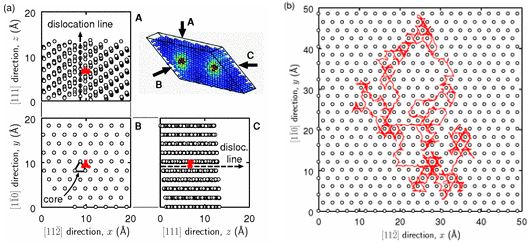
Here we demonstrate and characterize the H-diffusion behavior around a screw dislocation in body-centered cubic (bcc) α-Fe by performing path-integral molecular dynamics modeling and adopting an ab initio–based potential. Counterintuitively, our results indicate that the H diffusivity along the dislocation line is significantly lower than lattice diffusion. Thus, the “fast” pipe diffusion does not occur for H in α-Fe.
ページトップHajime Kimizuka, Hideki Mori, and Shigenobu Ogata, "Effect of Temperature on Fast Hydrogen Diffusion in Iron: A Path-Integral Quantum Dynamics Approach", Physical Review B, 83-9 (2011) 094110-1-7.

Here we explicitly present the diffusion coefficients (D) and activation energies (Ea) of interstitial H in α-Fe over a temperature range of 100 to 1000 K. These values were predicted by applying path-integral molecular dynamics modeling based on first principles. The obtained D and Ea values exhibit clear non-Arrhenius temperature dependence and a transition from quantum to classical behavior at around 500 K. Our results show that the quantum effects not only significantly lower the diffusion barrier but also change the diffusion pathway even at room temperature; thus, fast diffusion becomes possible.
ページトップHideki Mori, Hajime Kimizuka, and Shigenobu Ogata, "Microscopic Phase-Field Modeling of Edge and Screw Dislocation Core Structures and Peierls Stresses of BCC Iron", Journal of the Japan Institute of Metals, 75-2 (2011) 104-109. [in Japanese].
We investigate edge and screw dislocation core structures and Peierls stresses of BCC iron using microscopic phase-field (MPF) modeling. Parameters needed for the MPF modeling, such as the generalized-stacking-fault (GSF) energy, are determined based on first principles density functional theory (DFT) calculations. Screw dislocation core has six-fold symmetric structure and 0.05 nm width. The edge dislocation core is three times wider than the screw dislocation core. The Peierls stresses of edge and screw dislocations are estimated as 0.07 GPa and 2.8 GPa, respectively.
ページトップMasahiro Yamamoto, Kohei Kunizawa, Akinori Fujinami, Shigenobu Ogata, and Yoji Shibutani, "Formation of Atomistic Island in Al Film Growth by Kinetic Monte Carlo", Journal of Computational Science and Technology, 3-1 (2009) 148-158.
Kinetic Monte Carlo (KMC) method realizes the millisecond or second order atomistic thin film growth. Twenty five kinds of events which may occur on Al(111) surface were classified. An attempt frequency and an activation energy of each event were defined using vibration analyses and nudged elastic band (NEB) method by which the minimum energy path (MEP) can be reasonably predicted. Temperature and deposition rate dependences of Al(111) film growth were intensively investigated in the present paper. The higher temperature and the lower rate drive the layer-by-layer film structural change. Two types of islands (fcc and hcp) were seen by modeling without considering the events of diffusion of dimer and trimer, while only fcc islands remain with considering such events. Thus, we find that the primitive events of diffusion of dimer and trimer take important roles in determination of surface morphology.
ページトップMasato Wakeda, Shibutani Yoji, and Shigenobu Ogata, "Atomistic Formation Mechanism of Multiple Shear Bands in Amorphous Metals", Journal of the Society of Materials Science, Japan, 57-2 (2008) 119-125. [in Japanese].
At room temperature, plastic deformation of amorphous metals is localized in narrow bands, so called shear bands (SBs), which is a key issue of their brittle/ductile deformations. The extremely disordered structure and the abrupt fracture obtained in the experiments hinder us from making clear the nature and dynamics of SBs. In this study, atomistic modeling to produce the multiple shear bands (MSBs), not single shear band, was proposed, and the evolution process of MSBs including their coalescence and stationary was investigated using molecular dynamics simulations. We prepared a plate of Cu-Zr binary amorphous alloy model by the melt-quench process, and then performed uniaxial tensile and compressive tests under plane stress condition. During the loading, the deformation was suddenly localized in narrow bands shortly after the onset of yielding. The propagation of SBs was accompanied with drastic stress drop and significant local heating caused by the friction of atoms. Also, critical stresses of SB nucleation considerably differed between under tension and compression. This result indicates that Tresca or von Mises criterion, commonly used as a yield condition in the crystalline metals, is not appropriate to describe the yielding of the amorphous metals. The SB angles to the loading axis are observed to be 45∼57° under tension, while 40∼46° under compression. These angles agree well with the fracture angles observed in the experiments with multi-component metallic glasses. It is concluded that the critical stress state of SB nucleation is dependent on not only the shear stress but also the stress normal to the SB, and it can be described by Mohr-Coulomb criterion.
ページトップFutoshi Shimizu, Shigenobu Ogata, and Ju Li, "Theory of Yield Point in Metallic Glass and Molecular Dynamics Calculations", Materials Transactions, 48-11 (2007) 2923-2927.

The aged-rejuvenation-glue-liquid (ARGL) shear band model has been proposed for metallic glasses (Acta Mater. 54 (2006) 4293), based on small-scale molecular dynamics simulations up to 20,000 atoms and thermomechanical analysis. The model predicts the existence of a critical lengthscale ∼10 nm, above which melting could occur in shear-alienated glass. Large-scale molecular dynamics simulations with up to 5 million atoms have directly verified this prediction. When the applied stress exceeds the glue traction (computed separately before in a shear cohesive zone, or an amorphous-amorphous ``generalized stacking fault energy'' calculation), we indeed observe maturation of the shear band embryo into bona fide shear crack, accompanied by melting. In contrast, when the applied stress is below the glue traction, the shear band embryo does not propagate, becomes diffuse, and eventually dies. Thus this all-important quantity, the glue traction which is a property of shear-alienated glass, controls the macroscopic yield point of well-aged glass. We further suggest that the disruption of chemical short-range order (``chemical softening'') governs the glue traction microscopically. Catastrophic thermal softening occurs only after chemical alienation and softening in our simulation, after the shear band embryo has already run a critical length.
ページトップJunyoung Park, Yoji Shibutani, Masato Wakeda, and Shigenobu Ogata, "Influence of Size and Number of Nanocrystals on Shear Band Formation in Amorphous Alloys", Materials Transactions, 48-5 (2007) 1001-1006.
In this study, binary (copper and zirconium) amorphous metals with embedded nanosized crystal structures are subjected to uniaxial tension using molecular dynamics simulations to reveal the mechanism of shear band structure formation. The number and the size of the nanocrystals are chosen as the study parameters. The number of nanocrystals affects the stress-strain curve and shear band formation while the size of the nanocrystals does not significantly affect the results. As reported in the experimental work published so far, under tension coalescent voids are found in the shear bands or at the interface between crystalline and amorphous materials. The simulation results show that the number of shear bands under compressive loading is much larger than that under tensile loading. We also found that, even under compressive loading, the shear bands started from regions with enough free volume.
ページトップ Ogata Laboratory
Ogata Laboratory